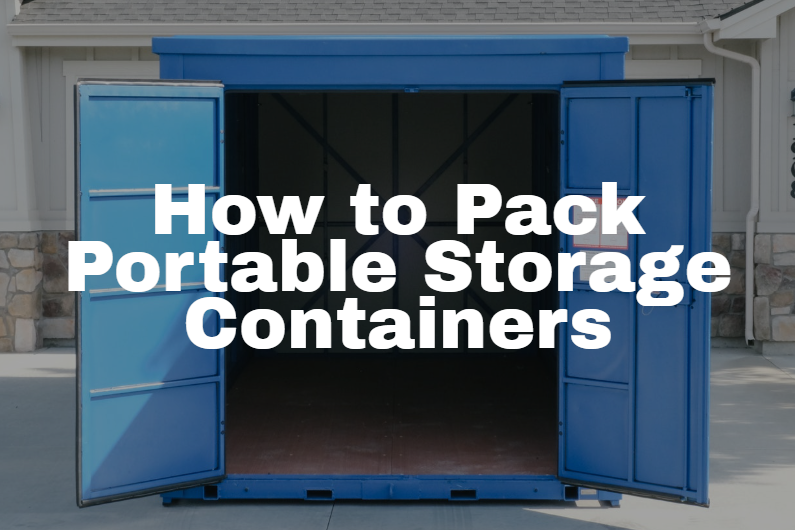A typical American will move over eleven times in their lifetime. Almost 31 million people moved in the United States in 2019 alone.
Yet, despite how often we do it, we’re often stressed about how to move efficiently. Efficient and safe moving practices start with proper storage.
If you store your goods correctly, they won’t get damaged when you drive them across the country. But packing and storing everything you own, for a move, isn’t intuitive.
There are pros and cons to each option, including:
- shipping items through the mail
- renting a moving truck
- using a portable storage container
In this piece, we’ll focus on portable storage containers. They grant you some advantages over the other options.
You can keep a storage container set up in your yard for as long as you want. This is a better situation than a rented moving truck.
You also get to control how you pack items. You lose that control when you ship your things via mail truck.
To get the most out of this process, we’ll walk through the best practices. Here’s how to pack a storage container in eleven steps.
1. Position Container for Easy Access
One of the first tips for packing a storage container is setting it up well. Set the container up at ground level.
Keep it in your yard. You can have the container for as many months as you pay for.
Set the container upon the flat, stable ground. Keep it close to the place you’ll be carrying your goods from.
2. Pre-Pack Boxes for Container Storage
Set yourself up for success by pre-packing your boxes. This way, you won’t have additional packing to do when you’re packing a storage container.
Some pre-packing strategies apply broadly. For example, do not over-stuff boxes. Yet, other pre-packing tips only apply to some items.
Fragile Items
When packing boxes, wrap all fragile items carefully. Use separators for glassware, to create sub-boxes within a box. Cushion fragile objects in packing paper, then bubble wrap.
Pack them into a box (or sub-box) tightly enough that they won’t shake when the container moves. Pad the floor and corners of the box. Reinforce the box with packing tape.
Furniture and Clothes
To maximize space, compress clothes and fabrics. Use vacuum-seal bags to protect the condensed fabrics.
Disassemble furniture. This way, you can pre-pack the furniture parts. Pad and box all furniture parts safely. Consider labeling furniture parts boxes so you don’t accidentally separate them.
Clean and dry all goods before you pack them. This reduces the risk of moisture build-up. Eliminating moisture prevents molds.
3. Separate Heirlooms and Important Documents
Don’t pack everything you own when you move. Some items are so important that even the smallest loss risk is unacceptable.
Keep all birth certificates and legal documents on your person. Likewise, you might have heirloom jewelry or antique instruments.
Even though it’s possible to pack and transport these items reasonably safely, you might want zero risks. In that case, keep these items in a specialized, secure, padded box.
Carry the box yourself. Or, hand it off directly to someone you trust.
4. Create Wall-Like Layers in Container
Layer your boxes vertically. Start packing on the floor against a wall, then build to the ceiling. Pack the wall as tightly as possible.
Keep the heaviest boxes on the floor. Or, keep them as low as possible. Use similarly-sized boxes as much as you can.
5. Distribute Weight Evenly
High on the list of storage container tips is balance. Distribute weight evenly throughout the portable container.
Specifically, balance weight horizontally. Both sides and ends of the container must weigh the same. This prevents shifting and tilting during transport.
Pack the heaviest items on the bottom. Keep weight even by composing each “wall” with box combinations of the same weight.
After packing walls, start at the center of the floor. Then pack outward, evenly, in all directions. Do this until you reach the walls.
6. Fill In Gaps
The next set of tips for packing a storage container concerns how you fill in gaps. Once you pack in all your boxes, there will be different-sized gaps.
The best way to fill gaps is to pack big items first. Then, fill in gaps with the smaller items. But, sometimes there are still gaps after that.
Fill remaining gaps with cushions. Gap cushion options include:
- packaging airbags
- polystyrene packing material
- foam sheet or roll
- packing paper
Polystyrene packing material is spray foam. You can mold it into almost any shape easily. It’s a useful, gap-filling cushion both inside boxes and between them.
7. Protect From Light and Heat
Protection encompasses many storage container packing tips. You can cover items to protect them from light and heat. In some cases, you’ll need to apply protective covers or casings before you pack the boxes into the container.
There are a variety of covers that can protect your cargo. Some coverings are tarp-like and drape over a whole set of boxes.
Others are cube-like. These are cut to fit a box snugly. Cargo covers are made from different materials, including:
- polyurethane
- canvas
- water-resistant polyester
Some cargo covers are insulated and reflective. These covers help a box maintain its internal temperature. They are thermos-like in nature.
8. Secure Stored Items for Transport
Once you’ve packed in your boxes, you’ll need to secure them. Do this before you move the container.
Typically, you’ll need to strap your boxes to the floor or sides of the container. You can also secure your cargo with nets (called webbing). Straps and nets are part of a cargo securement system.
A cargo securement system includes anchor points, braces (i.e. straps, chains, or bars that keep boxes in place), and edge protection.
Straps, Cords, and Chains
Braces hold your boxes in place directly. They brace against the container’s movement when it’s in motion, keeping the boxes steady. Braces include:
- ratchet straps
- bungee cords
- webbing
- logistic beams
- chains
Different types of cargo require different restraint tools. Ratchet straps and bungee cords balance resistance and elasticity well in most moving contexts. But, it’s wise to research the pros and cons of each option in regards to transporting your own unique items.
To secure boxes, braces must be tight. You can tighten straps with a ratchet winder. You can’t typically tighten bungee cords, so choose varying bungee cord lengths.
Anchor Points
Anchor points are attachment loci for braces. Inside storage containers, you might set up an attachment point system in the form of tracks.
Tracks run along the walls and floor of a container. Popular track systems include:
- e-track systems
- a-track systems
- f-track systems
- l-track systems
These systems are metal tracks with slots. Ratchet straps and other braces have end-fittings that snap into these slots tightly. You can explore many combinations of end-fittings and anchor points to see which are right for you.
There are attachment-point options beyond tracks. These include anchor rings, pockets, and tie-downs.
Edge and Corner Protectors
Edge protectors keep boxes safe from the pressure of braces. These protectors redistribute the force a strap presses against an item to hold it in place. This is less of a risk with webbing.
Edge protectors also keep sharp edges from cutting straps. These devices are usually plastic. They are molded at 90° angles.
9. Prevent Mold and Mildew
One of the best storage container packing tips is to prevent mold and mildew. Mold and mildew thrive in dark, damp spaces.
Your storage container will be dark. So, it’s important to keep it dry.
Powders, Gels, Barriers, and Appliances
One way to keep your container dry is baking soda. Baking soda is a safe mold-killer. Spread a baking soda paste in cracks and corners to prevent mold growth.
Alternately, use desiccators. Desiccators are silicate gels that absorb moisture. engineers also call these gels desiccants.
Manufacturers label desiccators as “anti-moisture packets.” You can combine them with polyurethane sheets to create a vapor barrier. Shroud your boxes with a vapor barrier to prevent moisture.
Finally, consider a dehumidifier. This electronic appliance removes moisture from the air.
10. Lock Your Container
Your container will come with a lock. Lock your storage container in-between loading. This prevents theft.
Containers come with a range of lock options. Talk to the storage of shipment company about choosing the best lock for your needs.
11. Load at an Easy Pace
Rushing is a good way to damage your things. With a storage container, you have as long as you need to pack up your items. So, pace yourself.
Pacing yourself includes taking time and not over-exerting your muscles. Only lift one heavy item at a time. Work with a friend or professional movers to save yourself strain.
Portable Storage Containers in Boise, Idaho
If you want a portable storage container, we’ll get you the box you need. You can pack three to four room’s worth of furniture in one of our large storage containers. And if you’re packing light, a small box can still carry two-and-a-half tons of cargo.
No matter why you’re relocating, talk to the experts in container transportation. We’ll give you the insights and advice you need to make wise moving choices. Contact us today.


